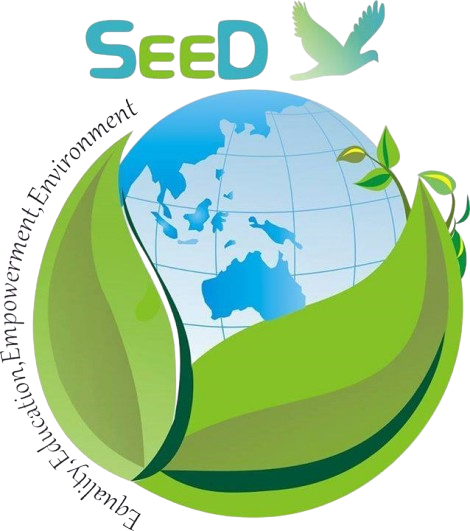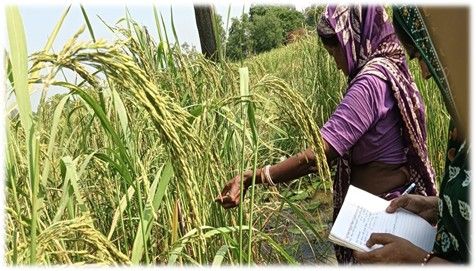






Objective:
To enhance the adaptive capacity of smallholder farmers in saline-prone coastal areas through salt-tolerant cropping systems and localized seed banks, enabling cultivation on salt-inundated lands while establishing community-based climate-resilient seed banks to ensure year-round access to quality seeds and reduce disaster-induced crop losses by at least 50%.
Overview:
The Sundarbans region faced devastating agricultural losses following Cyclones Amphan (2020) and Yaas (2021), which destroyed roughly 70% of standing crops and rendered traditional paddy varieties unproductive due to saline intrusion. Over 40% of arable land became affected by salinity, causing a 30-40% decline in agricultural income and forcing many farmers into debt or migration. The timing of Cyclone Yaas during the pre-monsoon season meant farmers lost both standing crops and their ability to plant for subsequent seasons.
Patharpratima block, classified as Very High Damage Risk Zone-B with probable maximum surge heights of 12-13 meters, represents one of the most cyclone-vulnerable areas in West Bengal. The region's geography of riverine islands separated by tidal channels makes communities physically isolated and extremely exposed to storm surges. Most families are smallholder farmers living at subsistence level, with over half depending on climate-sensitive agriculture as their primary livelihood.
In response to this crisis, SEED launched a comprehensive climate-resilient agriculture initiative combining scientific expertise with community participation. The project established five community seed beds strategically located with fresh water access, producing sufficient saplings for 550 farmers through a decentralized system. Collaboration with the Rice Research Institute (Government of West Bengal) ensured access to scientifically tested salt-tolerant varieties including Luna Barial, Luna Subarna, BINA Dhan-8, BINA Dhan-10, and Jarva, specifically selected for Sundarbans soil conditions.
The methodology integrated community ownership through local influencers, experienced farmers, and Self-Help Group members who became agents of change. Three climate-resilient seed banks were established in targeted Gram Panchayats, managed by local committees composed of women's self-help groups and farmer cooperatives. Each seed bank was stocked with surplus salt-tolerant paddy seeds and foundation seeds from the Rice Research Institute, with training provided on preservation techniques using sun-drying, airtight containers, and organic pest deterrents.
A comprehensive capacity building program involved agricultural scientists from IIT Kharagpur, covering theoretical sessions on climate change impacts, practical training on salt-tolerant cultivation, and demonstration plots. Training modules addressed soil management in saline conditions, water management techniques, integrated pest management, and post-harvest processing, with special emphasis on integrating indigenous knowledge with modern climate-resilient practices.
The project's "Community Participation for Community Benefit" philosophy enabled restoration of agricultural livelihoods while simultaneously establishing institutional mechanisms for future disaster preparedness. Partnerships with government agencies, local CBOs like Society for Durbachati Social Action & Transformation, and various Local Farmer Groups ensured technical credibility, resource support, and community ownership throughout implementation.
Impact:
550 smallholder farmers successfully cultivated salt-tolerant paddy on previously barren saline lands, transforming scorched fields into productive agricultural plots.
45% reduction in crop losses due to salinity and flooding compared to previous cyclone impacts, enabling farmers to absorb climate shocks with significantly less trauma.
Establishment of 3 community-managed seed banks across 10 villages, providing secure access to hundreds of kilograms of salt-tolerant paddy seeds for 1,200 households.
Restoration of paddy cultivation enabling farmers to harvest surplus beyond family consumption needs, reversing years of zero yields from salt-contaminated fields.
250 acres of farmland adopted sustainable farming practices including organic compost use and rainwater harvesting, improving soil quality and reducing chemical fertilizer expenses.
Broken cycle of post-disaster dependency where farmers previously waited for government or NGO seed aid, now having immediate access for re-sowing after disasters.
60% of participating farmers no longer consider migration as their primary coping strategy, with some young men contemplating return from city labor jobs.
Enhanced household income stability with families able to meet rice requirements and sell excess grain in local markets for the first time in years.
Preserved genetic diversity through conservation of local strains and introduced salt-tolerant varieties in community seed banks year to year.
Increased women's involvement in decision-making through SHGs and seed bank committees, empowering them within households and communities.
Created local resource persons and lead farmers capable of acting as community trainers, reducing reliance on external experts for future sustainability.
Established foundation for scaling approach to other vulnerable coastal regions through demonstrated 45% crop loss reduction and quantified livelihood improvements.



Subscribe to the SEED Newsletter — and be part of the change!